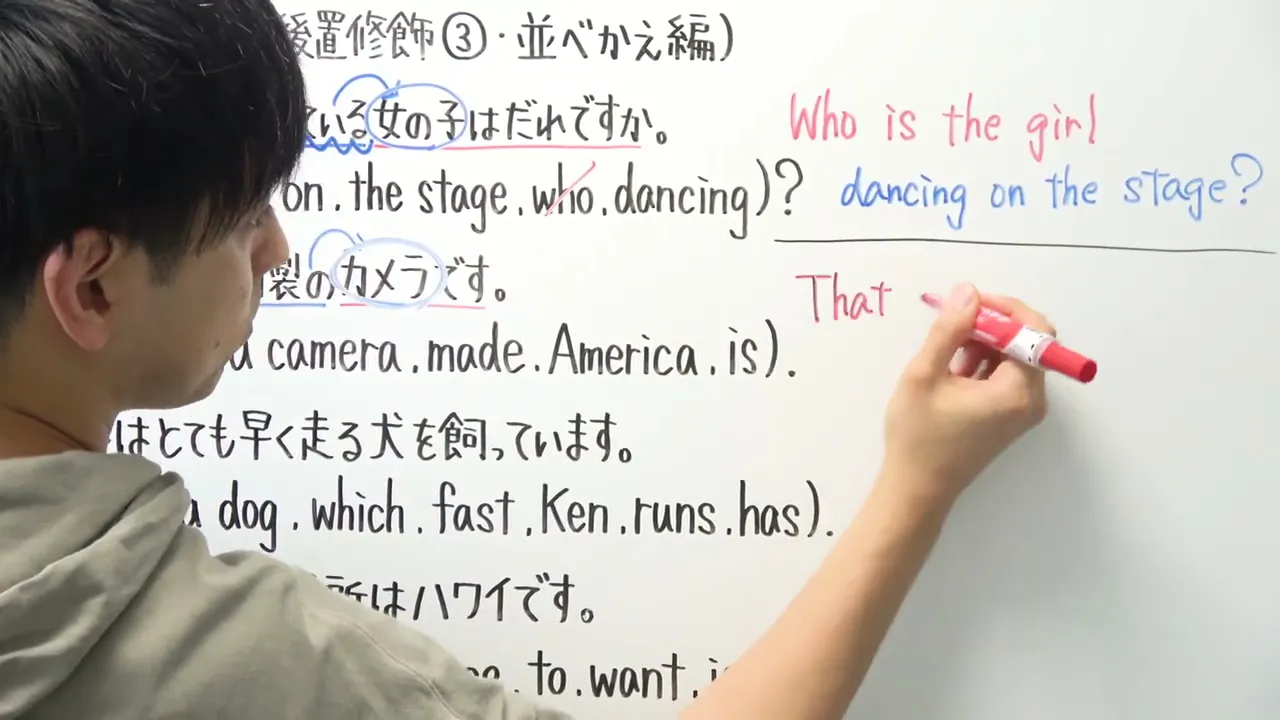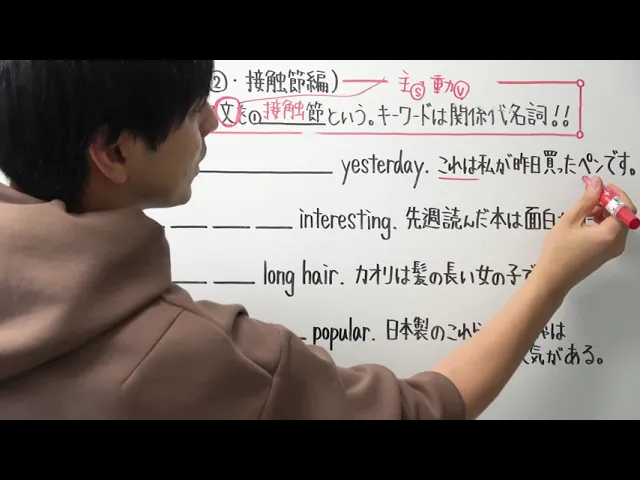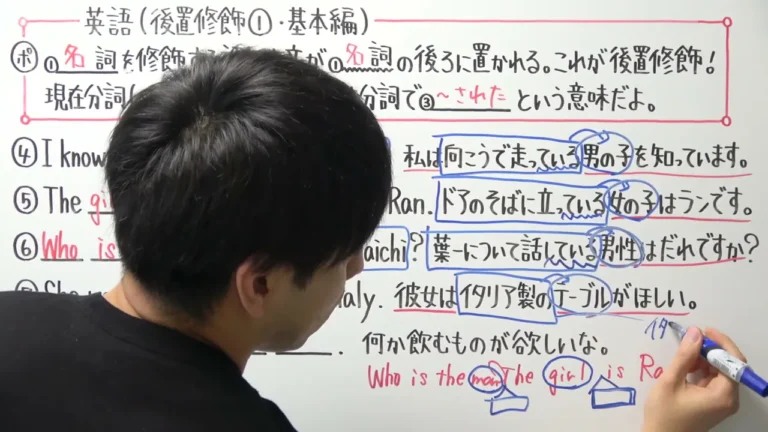後置修飾⓷
これらの質問は、レッスンで教えられたすべてのポイントをカバーし、Bloom’s Taxonomyの各レベルで知識、理解、応用、分析、評価、創造を促すように設計されています。
Bloom’s Taxonomy Comprehension Check Questions
Knowledge (知識)
- 後置修飾の並び替え問題で最初に確認すべきことは何ですか?
- What is the first thing you should×「What is the first thing you should」は「最初にすべきことは何ですか」という意味です。
例文:
What is the first thing you should do when you start a project?
プロジェクトを始める時に最初にすべきことは何ですか? identify×「identify」は「特定する」という意味です。
例文:
You should identify the main problem.
あなたは主な問題を特定する必要があります。 when tackling×「tackling」は「取り組む」という意味です。
例文:
We are tackling a difficult problem.
私たちは難しい問題に取り組んでいます。 post-modification rearrangement×「post-modification rearrangement」は「後置修飾の並び替え」という意味です。単語やフレーズを並び替えて後置修飾を作る問題です。
例文:
Practice post-modification rearrangement to improve your English.
英語力を向上させるために後置修飾の並び替えを練習しましょう。 questions?
- What is the first thing you should×「What is the first thing you should」は「最初にすべきことは何ですか」という意味です。
- このレッスンではどのような表現が、後置修飾を作成する上で重要でしたか?
- What type of expressions×「What type of expressions」は「どのような表現」という意味です。
例文:
What type of expressions are used in this poem?
この詩ではどのような表現が使われていますか? were important×「important」は「重要」という意味です。
例文:
It is important to practice every day.
毎日練習することが重要です。 for creating×「creating」は「作る」という意味です。
例文:
He is creating a new sculpture.
彼は新しい彫刻を作っています。 post-modifiers×「post-modifiers」は「後置修飾語」の複数形です。名詞を後ろから修飾する語句や句を指します。
例文:
Post-modifiers are used to add detail to nouns.
後置修飾語は名詞に詳細を加えるために使われます。 in this lesson?
- What type of expressions×「What type of expressions」は「どのような表現」という意味です。
- 関係代名詞の主格と目的格の違いは何ですか?
- What is the difference between×「What is the difference between」は「〜の違いは何ですか」という意味です。
例文:
What is the difference between these two methods?
この二つの方法の違いは何ですか? the subject and object forms of×「subject and object forms of」は「〜の主格と目的格」という意味です。
例文:
What is the difference between the subject and object forms of the pronoun?
その代名詞の主格と目的格の違いは何ですか? relative pronouns×「relative pronouns」は「関係代名詞」の複数形です。先行詞を修飾する節を導く代名詞です (who, which, thatなど)。
文法説明:
- 主格の関係代名詞は関係節の中で主語の役割をする(例:The man *who* came here is my friend)
- 目的格の関係代名詞は関係節の中で目的語の役割をする(例:The book *that* I read is interesting)
- 目的格の関係代名詞は省略できる場合がある
例文:
The man *who* is sitting there is my father.
そこに座っている男性は私の父です。
※「who」は主格の関係代名詞です。
The book *that* I bought was very interesting.
私が買った本はとても面白かったです。
※「that」は目的格の関係代名詞です。
よくある間違い:
- 主格と目的格の使い分けに注意
- 主格の関係代名詞は省略できない場合が多い
- 目的格の関係代名詞は省略できる場合がある?
- What is the difference between×「What is the difference between」は「〜の違いは何ですか」という意味です。
Comprehension (理解)
- なぜ並び替え問題を解く際に、まず元々の文を見つける必要があるのですか?
- Why is it necessary to×「Why is it necessary to」は「なぜ〜する必要があるのですか」という意味です。
例文:
Why is it necessary to study grammar?
なぜ文法を勉強する必要があるのですか? find×「find」は「見つける」という意味です。
例文:
You need to find the key to open the door.
ドアを開けるための鍵を見つける必要があります。 the original sentence×「the original sentence」は「元の文」という意味です。
例文:
Please rewrite the original sentence.
元の文を書き直してください。 first when solving×「solving」は「解く」という意味です。
例文:
You must practice solving math problems.
あなたは数学の問題を解く練習をする必要があります。 rearrangement questions×「rearrangement questions」は「並び替え問題」という意味です。
例文:
Rearrangement questions can be challenging for language learners.
並び替え問題は語学学習者にとって難しいことがあります。?
- Why is it necessary to×「Why is it necessary to」は「なぜ〜する必要があるのですか」という意味です。
- 関係代名詞が省略される場合、接触節はどのように形成されますか?
- How is a contact clause×「contact clause」は「接触節」という意味です。関係代名詞が省略された関係節です。
文法説明:
- 関係代名詞(who, which, thatなど)が省略されている
- 後置修飾として名詞を修飾する
- 主語と動詞が含まれることが多い
- 省略された関係代名詞は目的格であることが多い
例文:
The book I bought yesterday is interesting.
私が昨日買った本は面白い。
※「I bought yesterday」は接触節です。
よくある間違い:
- 関係代名詞が常に省略できるわけではない
- 日本語の感覚では関係代名詞を省略しない場合が多い
- 主格の関係代名詞は省略できないことが多い formed×「formed」は「形成される」という意味です。
例文:
How is a contact clause formed?
接触節はどのように形成されますか? when a relative pronoun×「a relative pronoun」は「関係代名詞」という意味です。先行詞を修飾する節を導く代名詞です (who, which, thatなど)。
例文:
A relative pronoun is used to connect two clauses.
関係代名詞は二つの節をつなぐために使われます。 is omitted×「is omitted」は「省略される」という意味です。
例文:
Sometimes a word is omitted in a sentence.
時には文の中で単語が省略されることがあります。?
- How is a contact clause×「contact clause」は「接触節」という意味です。関係代名詞が省略された関係節です。
- 主格の関係代名詞は、接触節で省略できますか?その理由も教えてください。
- Can a subject relative pronoun×「a subject relative pronoun」は「主格の関係代名詞」という意味です。関係節の中で主語の役割をする関係代名詞です (who, which, thatなど)。
例文:
The person who is speaking is my teacher.
話している人は私の先生です。
※「who」は主格の関係代名詞です。 be omitted×「be omitted」は「省略される」という意味です。
例文:
The article can be omitted in this context.
この記事は、この文脈では省略することができます。 in a contact clause×「a contact clause」は「接触節」という意味です。関係代名詞が省略された関係節です。
文法説明:
- 関係代名詞(who, which, thatなど)が省略されている
- 後置修飾として名詞を修飾する
- 主語と動詞が含まれることが多い
- 省略された関係代名詞は目的格であることが多い
例文:
The book I bought yesterday is interesting.
私が昨日買った本は面白い。
※「I bought yesterday」は接触節です。
よくある間違い:
- 関係代名詞が常に省略できるわけではない
- 日本語の感覚では関係代名詞を省略しない場合が多い
- 主格の関係代名詞は省略できないことが多い? Please explain why×「Please explain why」は「理由を説明してください」という意味です。
例文:
Please explain why you made that decision.
なぜその決断をしたのか理由を説明してください。.
- Can a subject relative pronoun×「a subject relative pronoun」は「主格の関係代名詞」という意味です。関係節の中で主語の役割をする関係代名詞です (who, which, thatなど)。
Application (応用)
- 「私が昨日買ったスマホは壊れた」という文を英訳するために、正しい語順に並び替えてください。
- Reorder the following words×「Reorder the following words」は「次の単語を並び替える」という意味です。
例文:
Reorder the following words to make a sentence.
次の単語を並び替えて文を作りなさい。 to make a sentence in English.
(yesterday, I, is, the, bought, smartphone, broken)
- Reorder the following words×「Reorder the following words」は「次の単語を並び替える」という意味です。
- 「その店で売られているパンは美味しい」という文を英語に翻訳するために、正しい語順に並び替えてください。
- Reorder the following words×「Reorder the following words」は「次の単語を並び替える」という意味です。
例文:
Reorder the following words to make a sentence.
次の単語を並び替えて文を作りなさい。 to make a sentence in English.
(is, that, bread, at, the, sold, store, delicious)
- Reorder the following words×「Reorder the following words」は「次の単語を並び替える」という意味です。
- 以下の日本語の語句を英訳しなさい。
- Translate the following Japanese phrases into English×「Translate the following Japanese phrases into English」は「以下の日本語の語句を英語に翻訳しなさい」という意味です。
例文:
Translate the following Japanese phrases into English.
以下の日本語の語句を英語に翻訳してください。:- 舞台の上で踊ってる女の子
- とても早く走る犬
- Translate the following Japanese phrases into English×「Translate the following Japanese phrases into English」は「以下の日本語の語句を英語に翻訳しなさい」という意味です。
Analysis (分析)
- 並び替え問題を解く際に、主語と動詞を特定することが重要なのはなぜですか?
- Why is it important to×「Why is it important to」は「なぜ〜することが重要なのですか?」という意味です。
例文:
Why is it important to drink water every day?
なぜ毎日水を飲むことが重要なのですか? identify the subject and verb×「identify the subject and verb」は「主語と動詞を特定する」という意味です。
例文:
Identify the subject and verb in this sentence.
この文の主語と動詞を特定しなさい。 when solving rearrangement questions×「solving rearrangement questions」は「並び替え問題を解く際に」という意味です。
例文:
Solving rearrangement questions requires logical thinking.
並び替え問題を解くには論理的思考が必要です。?
- Why is it important to×「Why is it important to」は「なぜ〜することが重要なのですか?」という意味です。
- このレッスンで提示された並び替え問題で、なぜ関係代名詞を省略できる場合とできない場合があるのか分析してください。
- Analyze why×「Analyze why」は「なぜ〜かを分析する」という意味です。
例文:
Analyze why this happened.
なぜこれが起こったのか分析しなさい。 relative pronouns×「relative pronouns」は「関係代名詞」の複数形です。先行詞を修飾する節を導く代名詞です (who, which, thatなど)。
例文:
Relative pronouns connect clauses.
関係代名詞は節を接続します。 can be omitted×「can be omitted」は「省略できる」という意味です。
例文:
Sometimes words can be omitted for brevity.
時々、簡潔にするために単語を省略できます。 in some of×「some of」は「〜のうちのいくつか」という意味です。
例文:
Some of the students were late.
生徒のうちの何人かが遅刻しました。 the rearrangement problems×「rearrangement problems」は「並び替え問題」という意味です。
例文:
Rearrangement problems can help improve understanding.
並び替え問題は理解を深めるのに役立ちます。 provided in this lesson×「provided in this lesson」は「このレッスンで提示された」という意味です。
例文:
The examples provided in this lesson are helpful.
このレッスンで提供された例は役立ちます。 but not others.
- Analyze why×「Analyze why」は「なぜ〜かを分析する」という意味です。
- 関係代名詞を使った文と、接触節を使った文の構造上の類似点を分析してください。
- Analyze×「Analyze」は「分析する」という意味です。
例文:
Analyze the results of the experiment.
実験の結果を分析してください。 the structural similarities between sentences×「structural similarities between sentences」は「文の構造上の類似点」という意味です。
例文:
Analyze the structural similarities between these two languages.
これらの二つの言語の構造上の類似点を分析してください。 using relative pronouns×「relative pronouns」は「関係代名詞」の複数形です。先行詞を修飾する節を導く代名詞です (who, which, thatなど)。
例文:
Relative pronouns are essential for complex sentences.
関係代名詞は複雑な文に不可欠です。 and sentences using contact clauses×「sentences using contact clauses」は「接触節を使った文」という意味です。
例文:
Sentences using contact clauses are common in everyday speech.
接触節を使った文は日常会話でよく使われます。.
- Analyze×「Analyze」は「分析する」という意味です。
Evaluation (評価)
- 並び替え問題を通じて、後置修飾を理解することのメリットは何ですか?
- What are the benefits of×「What are the benefits of」は「〜のメリットは何ですか?」という意味です。
例文:
What are the benefits of exercise?
運動のメリットは何ですか? understanding post-modification×「post-modification」は「後置修飾」という意味です。名詞を後ろから修飾する語句や節を指します。
例文:
Post-modification adds detail to the noun.
後置修飾は名詞に詳細を追加します。 by using rearrangement questions×「rearrangement questions」は「並び替え問題」という意味です。
例文:
Rearrangement questions can improve sentence structure.
並び替え問題は文構造を改善することができます。?
- What are the benefits of×「What are the benefits of」は「〜のメリットは何ですか?」という意味です。
- 今回学んだ並び替えテクニックを基に、自分で文を並び替え、それが正しく後置修飾されているか評価してください。
- Based on×「Based on」は「〜に基づいて」という意味です。
例文:
Based on the information you have, what is your decision?
あなたが持っている情報に基づいて、あなたの決断は何ですか? the rearrangement techniques×「rearrangement techniques」は「並び替えのテクニック」という意味です。
例文:
Use the rearrangement techniques learned in the lesson.
レッスンで学んだ並び替えテクニックを使ってください。 you have learned, reorder the words×「reorder the words」は「単語を並び替える」という意味です。
例文:
Reorder the words in the sentence to make it correct.
その文を正しくするために単語を並び替えてください。 in your own sentence×「your own sentence」は「自分の文」という意味です。
例文:
Try to write your own sentence using the new word.
新しい単語を使って自分で文を書いてみてください。 and evaluate whether it uses×「evaluate whether it uses」は「それが〜を使っているかどうか評価する」という意味です。
例文:
Evaluate whether it uses the correct grammar.
それが正しい文法を使っているかどうか評価してください。 post-modification×「post-modification」は「後置修飾」という意味です。名詞を後ろから修飾する語句や節を指します。
例文:
Is post-modification used correctly in this sentence?
この文で後置修飾は正しく使われていますか? correctly×「correctly」は「正しく」という意味です。
例文:
You need to use the words correctly.
あなたは単語を正しく使う必要があります。.
- Based on×「Based on」は「〜に基づいて」という意味です。
- 並び替え問題を通じて、どのような点が後置修飾の理解を助けますか?
- In what ways do×「In what ways do」は「どのような点で〜が」という意味です。
例文:
In what ways do these two methods differ?
これらの二つの方法はどのような点で異なりますか? the rearrangement×「rearrangement」は「並び替え」という意味です。
例文:
The rearrangement of furniture changed the look of the room.
家具の並び替えが部屋の見た目を変えました。 problems help to improve your understanding×「help to improve your understanding」は「あなたの理解を深めるのに役立つ」という意味です。
例文:
How can this activity help to improve your understanding of the topic?
この活動は、どのようにあなたのトピックの理解を深めるのに役立ちますか? of post-modification×「post-modification」は「後置修飾」という意味です。名詞を後ろから修飾する語句や節を指します。
例文:
Post-modification can make a sentence more detailed.
後置修飾は文をより詳細にすることができます。?
- In what ways do×「In what ways do」は「どのような点で〜が」という意味です。
Creation (創造)
- あなたが昨日見た印象的な場面を説明する文を、後置修飾を使った並び替えで作成してください。
- Create a sentence×「Create a sentence」は「文を作成する」という意味です。
例文:
Create a sentence using the new vocabulary.
新しい語彙を使って文を作成してください。 using post-modification×「post-modification」は「後置修飾」という意味です。名詞を後ろから修飾する語句や節を指します。
例文:
Post-modification can make your writing more descriptive.
後置修飾はあなたの文章をより描写的にすることができます。 through rearranging given word groups×「rearranging given word groups」は「与えられた単語グループを並び替えることによって」という意味です。
例文:
Create your sentence by rearranging given word groups.
与えられた単語グループを並び替えて文を作成してください。 that describe a memorable scene×「describe a memorable scene」は「印象的な場面を説明する」という意味です。
例文:
Try to describe a memorable scene from your childhood.
あなたの子供時代の印象的な場面を説明してみてください。 you saw yesterday. - 過去分詞を使った後置修飾と、接触節を使った後置修飾をそれぞれ使って、自分で3つずつ文を作成してください。
- Make 3 sentences each×「Make 3 sentences each」は「それぞれ3つの文を作成する」という意味です。
例文:
Make 3 sentences each using different tenses.
異なる時制を使ってそれぞれ3つの文を作成してください。, using past participle post-modifiers×「past participle post-modifiers」は「過去分詞を使った後置修飾」という意味です。
例文:
The cake baked by my mother was delicious.
私の母によって焼かれたケーキは美味しかった。
※「baked by my mother」が過去分詞の後置修飾です。 and 3 sentences using contact clause post-modifiers×「contact clause post-modifiers」は「接触節を使った後置修飾」という意味です。
例文:
The book I read yesterday was fascinating.
私が昨日読んだ本は魅力的でした。
※「I read yesterday」が接触節を使った後置修飾です。, on a topic of your choice×「a topic of your choice」は「あなたが選んだトピック」という意味です。
例文:
Write a paragraph on a topic of your choice.
あなたが選んだトピックについて段落を書いてください。.
- Make 3 sentences each×「Make 3 sentences each」は「それぞれ3つの文を作成する」という意味です。
- 今回の内容を踏まえ、後置修飾の並び替え問題を効果的に解くための新たな戦略を提案してください。
- Based on the content of this lesson×「Based on the content of this lesson」は「このレッスンの内容に基づいて」という意味です。
例文:
Based on the content of this lesson, how would you solve the problem?
このレッスンの内容に基づいて、どうやって問題を解決しますか?, propose×「propose」は「提案する」という意味です。
例文:
Propose a solution to this problem.
この問題に対する解決策を提案してください。 a new strategy for×「a new strategy for」は「〜のための新しい戦略」という意味です。
例文:
Propose a new strategy for improving sales.
売上を改善するための新しい戦略を提案してください。 solving×「solving」は「解決する」という意味です。
例文:
He found a way of solving this complex problem.
彼はこの複雑な問題を解決する方法を見つけた。 post-modification rearrangement questions×「post-modification rearrangement questions」は「後置修飾の並び替え問題」という意味です。
例文:
Solving post-modification rearrangement questions requires logical thinking.
後置修飾の並び替え問題を解くには論理的思考が必要です。 effectively×「effectively」は「効果的に」という意味です。
例文:
How can we communicate effectively?
どのように効果的にコミュニケーションをとることができますか?.
- Based on the content of this lesson×「Based on the content of this lesson」は「このレッスンの内容に基づいて」という意味です。


